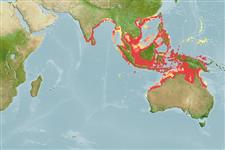Environment: milieu / climate zone / depth range / distribution range
Ekologi
laut berasosiasi dengan karang; kisaran kedalaman 2 - 80 m (Ref. 90102). Tropical; 24°N - 25°S, 75°E - 149°E (Ref. 55)
Western Indian Ocean: Mozambique (Ref. 41878). Indo-West Pacific: southern India and Sri Lanka to Philippines, New Guinea and Australia. Has been referred to as Lutjanus janthinuropterus and Lutjanus rangus (a junior synonym of Lutjanus bohar) by previous authors.
Size / Weight / umur
Maturity: Lm ? range ? - ? cm
Max length : 65.0 cm TL jantan/; (Ref. 55); common length : 35.0 cm TL jantan/; (Ref. 55)
Duri punggung (Keseluruhan (total)) : 10; duri punggung lunak (Keseluruhan (total)) : 13 - 14; Duri dubur: 3; Sirip dubur lunak: 8. Dorsal profile of head steeply sloped, snout profile slightly concave. Preorbital bone usually much greater than eye diameter, at least in large specimens. Preopercular notch and knob poorly developed. Scale rows on back rising obliquely above lateral line. Generally gray-brown or olive on the upper portion of the back and head, grading to whitish ventrally. The dorsal and caudal fins are dusky brown or black, frequently with a narrow white posterior margin. The anal, pelvic and pectoral fins are whitish with some dusky brown. Juveniles have a broad black horizontal band from snout tip to caudal fin base. Large juveniles with black mid-lateral stripe. Adults plain pinkish brown with dusky tail (Ref. 48635). Body depth 2.5-2.8 in SL (Ref. 90102).
Solitary or in small groups (Ref. 90102). Adults inhabit offshore reefs and muddy habitats. Juveniles are sometimes found in the vicinity of coral reefs, often located close to the shore where silting is moderate and visibility is reduced. Adults usually very deep (Ref. 48635). They feed on fishes and a variety of benthic invertebrates.
Life cycle and mating behavior
Maturities | Reproduksi, perkembang biakan | Spawnings | Egg(s) | Fecundities | Larva
Allen, G.R., 1985. FAO Species Catalogue. Vol. 6. Snappers of the world. An annotated and illustrated catalogue of lutjanid species known to date. FAO Fish. Synop. 125(6):208 p. Rome: FAO. (Ref. 55)
Status IUCN Red List (Ref. 130435)
ancaman kepada manusia
Harmless
penggunaan manusia
Perikanan: komersial
Alat, peralatan
laporan khas
muat turun XML
Sumber internet
Estimates based on models
Preferred temperature (Ref.
123201): 26.3 - 29.1, mean 28.3 °C (based on 1226 cells).
Phylogenetic diversity index (Ref.
82804): PD
50 = 0.5000 [Uniqueness, from 0.5 = low to 2.0 = high].
Bayesian length-weight: a=0.01479 (0.00706 - 0.03101), b=2.97 (2.81 - 3.13), in cm total length, based on LWR estimates for this Genus-body shape (Ref.
93245).
Trophic level (Ref.
69278): 4.0 ±0.65 se; based on food items.
Daya lenting (Ref.
120179): sedang, Waktu penggandaan populasi minimum 1.4 - 4.4 tahun (Preliminary K or Fecundity.).
Fishing Vulnerability (Ref.
59153): Moderate to high vulnerability (46 of 100).
Nutrients (Ref.
124155): Calcium = 27.2 [17.9, 38.8] mg/100g; Iron = 0.301 [0.196, 0.449] mg/100g; Protein = 18.6 [17.1, 19.9] %; Omega3 = 0.129 [0.094, 0.173] g/100g; Selenium = 67.3 [46.9, 95.6] μg/100g; VitaminA = 127 [24, 444] μg/100g; Zinc = 0.403 [0.331, 0.546] mg/100g (wet weight);
